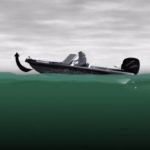Tournament Day – When Walleyes go into Hiding
This article was originally printed in the 2014 Nitro Performance Fishing Boats magazine and is reprinted here courtesy of Tracker Marine Group.
A dramatic look behind the scenes of WALLEYE tournament Fishing.
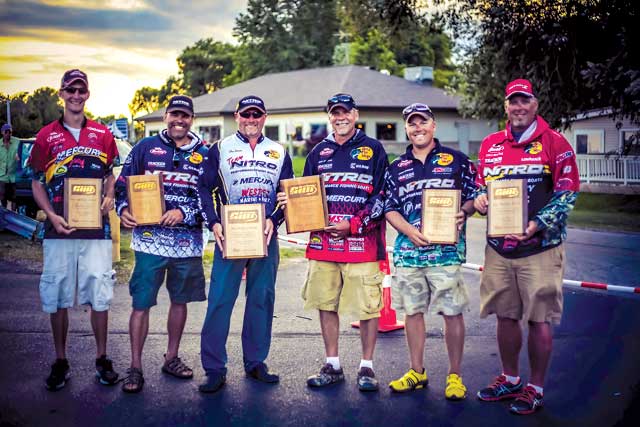 When four Northern fishing pros from two different generations get together to share what it’s like to fish the walleye circuit, you can count on plenty of colorful memories and a wealth of experience and fishing tips to go around. And plenty of stories too—not so much about the big ones that got away on tournament day…just the big ones that never even gave a bite!
When four Northern fishing pros from two different generations get together to share what it’s like to fish the walleye circuit, you can count on plenty of colorful memories and a wealth of experience and fishing tips to go around. And plenty of stories too—not so much about the big ones that got away on tournament day…just the big ones that never even gave a bite!
One thing all Northern anglers agree on: walleyes are one of the most fickle fishes around—here today, gone tomorrow. And as skilled as a pro might be, it’s why no angler or team has come to dominate the sport. Chase Parsons, who has fished tournaments as a pro since he was 20, says there’s one thing he learned right away: “Walleyes know when it’s tournament day. You can catch ’em five days straight in practice, but it’s almost a guarantee that the bite’s going to change on tournament day.”
Walleye fishing requires a vastly different skill set than bass fishing. With a wink in his eye and a bit of conviction in his voice, North Dakota NITRO Pro Team Angler Jim Carroll often says in his seminars, “From a walleye angler’s perspective, bass are stupid and easy to catch. With walleyes, there are so many unknowns and unknowables.” He marvels that bass anglers can pre-fish a tournament for two to three days before a tournament and develop patterns that pretty much hold up during the event.
That usually doesn’t work with walleyes because of their unpredictable, fast-changing whims.
Without a doubt, bass fishing requires a constant honing of casting techniques.
But successful walleye fishing requires a full arsenal of nearly every technique in the book, and then some—precision boat control to stay over the fish in deep water against strong winds and pounding waves, knowing how to present the bait in such rugged conditions, backtrolling, trolling with planer boards, spinners and crankbaits, vertical jigging on structure or pitching jigs to shoreline. Carroll says winning walleyes might be roaming in deep water chasing schools of suspended baitfish, or they might be in just a couple feet of water looking for perch or minnows near a weedline. “Rarely are all the walleyes doing the same thing in the same body of water at the same time.”
Fishing as a pro since 2002, Carroll starts thinking about each tournament one to two weeks out—reading the Internet, checking message boards, learning what kind of bite is going on, monitoring the weather forecasts, water conditions—nothing specific he says, just getting a feel. Once on-site, he advises, you need to filter your past experience and approach each tournament with a blank slate.
Pre-fishing for a tournament takes four to six days. Part is simply the wily nature of the fish. The other reason is that Northern lakes and reservoirs are so vast. Think natural waters like Green Bay and the Great Lakes, or manmade bodies like Lake Oahe in South Dakota, a 231-mile-long reservoir on the Missouri River system that’s 200 feet deep at full pool. A “small” lake in the walleye world might be 40 miles long and 10 miles wide. According to Gary Parsons, Chase’s Dad, his practice days—and tournament days—are often consumed with hours of graphing to locate the right fish before even wetting a line. “Top guns have to be expert hunters with their electronics,” he says. Walleyes are a schooling fish, very nomadic, moving on the run as they follow their food, or retreating when the water gets cloudy or a cold front blows through.
Keith Kavajecz, Gary’s brother-in-law, remembers some of his early days fishing these huge bodies of water. Electronics weren’t as sophisticated, and they didn’t have the fast boats. “You had to make a lot more decisions back then, based on time. On Lake Oahe, running at 30 miles an hour, deciding to head 20 miles up to Little Bend was a big deal, a really labored decision. But now it’s exciting to make long, rough-water runs, because the equipment can handle it.” Gary Parsons agrees, noting that when his practices have allowed it, he’s made one-way runs of 120 miles or more.
Gary and Kavajecz have seen walleye tournaments evolve a lot over the years. Early on, they participated in well over 100 walleye tournaments that featured wild-west style shotgun starts and “chase scenes.” Kavajecz still relishes the noise and race-like atmosphere of those days—when a real shotgun blasted everybody off at the same time. Back then it was the roar of 60- or 75-horsepower 2-cycle outboards running full throttle.
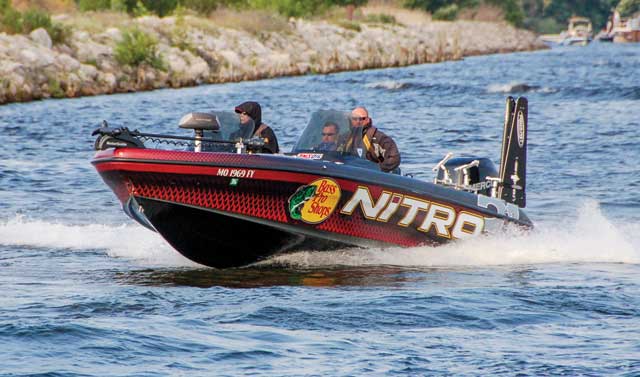 Gary remembers one start on Lesser Slave Lake in Alberta, Canada, where about 300 boats were strung out across the lake in very long starting line. The air was thick with the blue haze, acrid smell and raucous sounds of anglers idling and revving their engines, jockeying for position. Nervous chatter and excitement were rampant. Three choppers hovered overhead, preparing to film it from the air. At the shotgun, Gary and Kavajecz had one of the fastest boats, so they quickly broke into the lead and became the target of the first helicopter. Gary says he remembers looking up and was shocked to see the chopper’s landing gear just feet from his head. And Kavajecz says the downward thrust from the chopper blades exploded the water around them, giving them both a good dousing in the process.
Gary remembers one start on Lesser Slave Lake in Alberta, Canada, where about 300 boats were strung out across the lake in very long starting line. The air was thick with the blue haze, acrid smell and raucous sounds of anglers idling and revving their engines, jockeying for position. Nervous chatter and excitement were rampant. Three choppers hovered overhead, preparing to film it from the air. At the shotgun, Gary and Kavajecz had one of the fastest boats, so they quickly broke into the lead and became the target of the first helicopter. Gary says he remembers looking up and was shocked to see the chopper’s landing gear just feet from his head. And Kavajecz says the downward thrust from the chopper blades exploded the water around them, giving them both a good dousing in the process.
All the main walleye circuits have dropped those kinds of starts in favor of safety. Today’s starts, while still exciting, are much tamer with many of the high-powered engines now four-strokes—and quieter. Each team is given a number and heads out single file according to that number, one boat every 15 seconds or so. The numbers are switched up every day.
Chase has memories that go back a few years, too—to his very first tournament after he turned pro at Fox Lake in Illinois. He says the hardest part was waiting for the launch, sitting, drinking too many energy drinks, over-thinking, agonizing: the four good spots he’d found in practice, each one firing through his head, which one to start at? When the launch came, he settled down just a little and made his decision on where to run. He fished there all day—and caught one fish. Wound tighter at the end of the day, he forgot to pull his bow-mounted trolling motor back up, and took off at full speed. It peeled his bow mount back tight against the hull with the shaft bent into a perfect half moon. It’s the only time he ever did it, but he says it shows what nerves can do. He didn’t do any better on Days Two and Three either, and ended up 123 out of a field of 125. It was a tough drive home. But he knew he could fish and went back to try again. He was in the money the next seven tournaments he entered. His advice to rookies fishing their first tournament: “Try to slow everything down in your mind. Stick to your game plan and don’t jump around too much. Some days you’re going to catch ’em. Some days you’re not.”
In walleye tournaments, it seems the tales of defeat are every bit as plentiful and colorful as the stories of victory—perhaps more so—because they illustrate the legendary whims of the species. Carroll remembers a tournament down south on Bull Shoals Lake in Arkansas, where he had great success on practice days, trolling over the tops of old flooded trees, 40- to 50-feet deep, locked into a solid pattern. He caught anywhere from five to nine BIG 25- to 27-inchers each day. Dock talk was that most competitors were happy just catching 17- to 18-inch fish near the shore in 15 to 20 feet of water. The final practice day he caught a 29-1/4-inch walleye, and sort of had a premonition: “Why today?” He says he went out, stayed invested in his pattern and zeroed out, three days straight. The shad had left the trees and headed to shore—with the walleyes following. It was a long drive home, 1,200 miles alone in his truck—to think about what he’d learned. His lesson was short and sweet: “If you get stuck on something, it’ll bite you.”
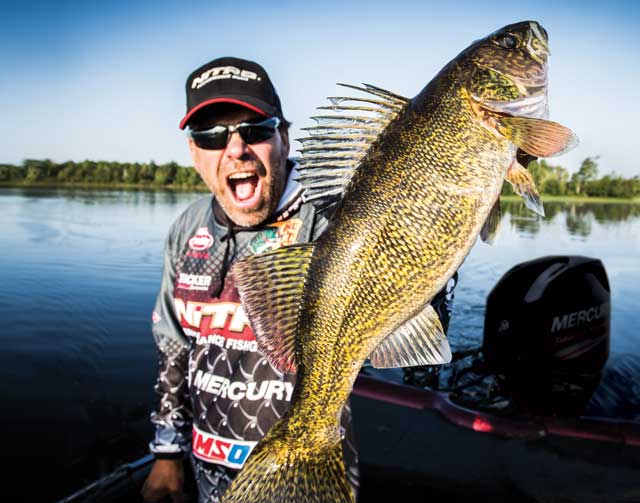 The best way for a beginner to get started in tournament fishing is to sign up as a co-angler in a walleye tournament that features a pro/partner/co-angler or pro/co-angler format. In a random drawing, beginners are paired with one or two tournament pros who have traveled the circuit and fished all kinds of waters. It’s to the pro’s advantage to teach the techniques quickly, so the co-angler is equipped to help add to the boat’s weight for the day. Kavajecz says he’s always honored when one of his former co-anglers sees him on the dock later and says it’s because of his teaching they started fishing tournaments. And he says some come back to fish against him as a pro.
The best way for a beginner to get started in tournament fishing is to sign up as a co-angler in a walleye tournament that features a pro/partner/co-angler or pro/co-angler format. In a random drawing, beginners are paired with one or two tournament pros who have traveled the circuit and fished all kinds of waters. It’s to the pro’s advantage to teach the techniques quickly, so the co-angler is equipped to help add to the boat’s weight for the day. Kavajecz says he’s always honored when one of his former co-anglers sees him on the dock later and says it’s because of his teaching they started fishing tournaments. And he says some come back to fish against him as a pro.
Kavajecz likes poker, and he likens the night before a tournament to a poker game, “We all have our hands. We know what we found in practice. Now we’re trying to find out what others think, what’s in their hand—not so much to beat them, but to make a right decision to be on the fish, not necessarily the easiest fish, but the winning fish. There’s plenty of swapping, jousting and bluffing to go around.” With these huge Northern bodies of water, it’s impossible to pre-fish the whole lake in five or six days. So on the walleye circuit, there’s a level of camaraderie, sharing and trust that develops among certain close-knit groups of anglers. For Kavajecz, Gary and Chase, the sharing is all in the family.
Kavajecz says sometimes he and Gary may choose not to pre-fish on the final day—using the time to make sure their boat and equipment are in top shape, fresh line and sharp hooks, everything organized and prepped for a win. And he says the competition often tries to read them, by whether they take that last day off. “More waypoints may or may not be as important as being physically and mentally prepared,” he says from experience. “I like days off.”
One major distinction between bass tournaments and many Northern walleye tournaments is state conservation enforcement of culling regulations and slot limits.
While most bass tournament anglers can cull all day, culling regulations in many walleye tournaments require that once you put a fish in the livewell, you can’t upgrade it later if you catch a bigger one. All four pros liken it to a mind game. For example, if you catch a 22-incher, you have to decide whether you can beat it later in the day. Chase says if you’re fishing aggressively and decide to throw it back, you may not catch anything later and you come up short. Kavajecz agrees, saying that after throwing a pretty big fish back, a half-hour lull without catching another seems like an eternity.
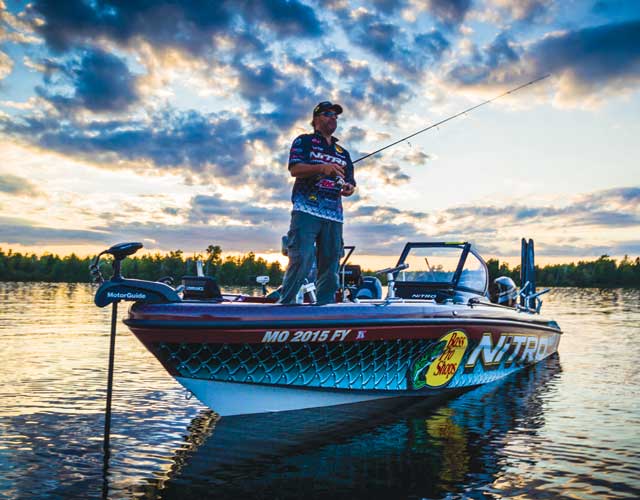 Slot limits are another regulation designed to protect and conserve state fisheries. For example, Mille Lacs in Minnesota is one of the hardest places to succeed in a tournament—because there’s such a narrow window of fish that qualify. A slot limit may say you can only keep one fish longer than 28 inches, and all the rest must be between 16 and 18 inches. Anything you catch between 18 and 28 is worthless. You may be the more skilled angler, and catch more fish than anyone else in the tournament, but if your fish don’t qualify within the slot, it’s the “lucky” angler who wins.
Slot limits are another regulation designed to protect and conserve state fisheries. For example, Mille Lacs in Minnesota is one of the hardest places to succeed in a tournament—because there’s such a narrow window of fish that qualify. A slot limit may say you can only keep one fish longer than 28 inches, and all the rest must be between 16 and 18 inches. Anything you catch between 18 and 28 is worthless. You may be the more skilled angler, and catch more fish than anyone else in the tournament, but if your fish don’t qualify within the slot, it’s the “lucky” angler who wins.
A relatively new and revolutionary tournament format, Catch-Record-Release (CRR), sets anglers (and the walleyes!) free of all these state regulations. And it’s proving to be the most effective format for conserving fishery resources. It’s a format pioneered by Anglers Insight Marketing (AIM), a grassroots, angler-owned (versus corporate-owned) tournament organization. In CRR, you get to catch (and “keep”) as many fish as you can all day. You measure each fish and round up ¼ inch, then record it with a digital photo and on a scorecard for the day. Take another “hero” shot of the angler holding it up. Quickly, you release the fish back into the water where it was caught, for other anglers to catch later. The co-angler becomes an independent third party who signs the scorecard to verify the results.
The boat’s seven longest fish are converted to weight and recorded on behalf of the team. Those who catch the most big fish win, plain and simple.
In CRR, there’s no mortality because fish are never put into a livewell. Anglers get to fish to the last minute, and can make an exhilarating so-called “hell run” back to weigh-in over 5- or 6-foot waves, arriving with just seconds to spare—with absolutely no worry about protecting their fish. The scorecard weigh-in is full of excitement and suspense, too, with photos of each angler’s catch projected above the audience on big-screen video. 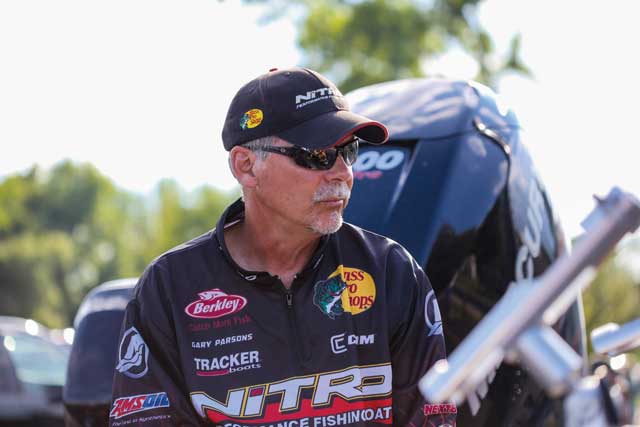 Anglers agree CRR is the fairest and most fun format to fish, because as Chase says, “The angler who catches the biggest fish wins, not the guy who can catch the two biggest ‘right’ ones, and then some others that come in just under the slot.” Carroll concurs. “CRR takes the luck out of it, plus it reduces local anglers’ resistance to tournament intrusions that can take out their biggest fish.”
Anglers agree CRR is the fairest and most fun format to fish, because as Chase says, “The angler who catches the biggest fish wins, not the guy who can catch the two biggest ‘right’ ones, and then some others that come in just under the slot.” Carroll concurs. “CRR takes the luck out of it, plus it reduces local anglers’ resistance to tournament intrusions that can take out their biggest fish.”
As long as he’s fished events, Gary says, “Something pulling on your line is not the thrill anymore. The real thrill is figuring out the puzzle. That’s what makes walleye such an alluring fish for me. Sometimes they’re more like a bass, at times more like a crappie, and sometimes like a salmon suspended out over deep water. They’re a very dynamic species to fish for. They’re just a blast! And sometimes you get the satisfaction of ‘Yep, I nailed it.’ I figured out Mother Nature, and at least she let me work on those fish for three or four hours before she changed the game on me.”
There are some things you CAN control in a tournament, Kavajecz reminds Gary. On the night before one, they both ate roasted chicken sandwiches, and on Day One, they ended up first and third. So next night, same thing. By the end of the tournament, after four straight nights of roasted chicken sandwiches, they had won first and second place. He says he, personally, won another championship on lasagna. Since you can’t control the fish he advises, don’t change the things that do work. One year, he and Gary built a really good season on ice cream sandwiches as a nightcap right before bed. And for a short time one year, he said he had a really good turkey pattern.
No doubt about it—walleyes are waiting. But where is the unknowable question.





